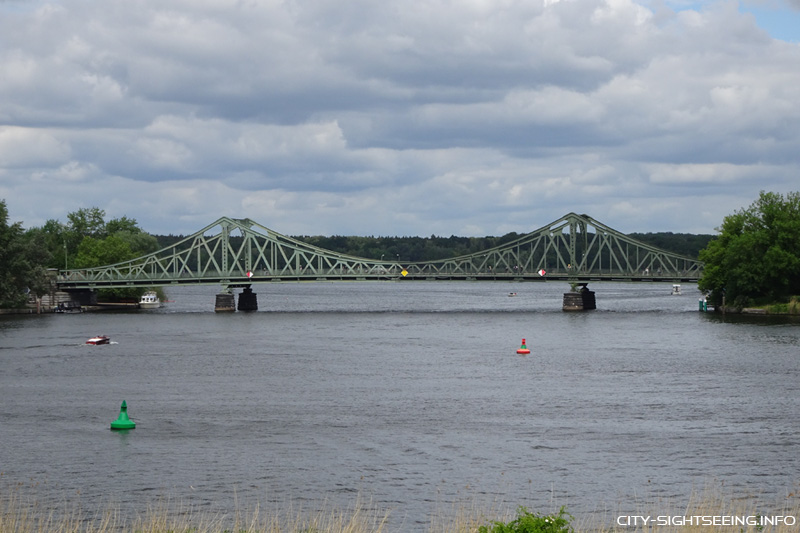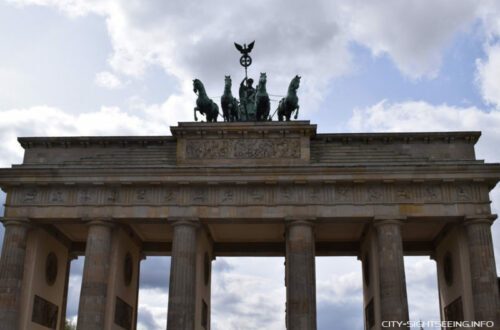Glienicke Bridge

The Glienicke Bridge connects the two cities of Potsdam and Berlin on the northeastern edge of Berlin. The bridge became particularly famous during the Cold War. It was the legendary setting for the third and final staged exchange of spies between the United States and the Soviet Union on February 11, 1986, gaining worldwide recognition. Due to its historical significance, it is considered one of the landmarks of both Potsdam and Berlin. Here you can find information about the Glienicke Bridge.
Table of Contents
History of the Glienicke Bridge
In 1907, the Glienicke Bridge was constructed on Bundesstraße 1. It spans the Havel River, connecting Berlin and Potsdam. The bridge is named after the nearby former estate of Klein Glienicke, where the Glienicke Palace is now located.
The regional border between Brandenburg and Berlin, as well as the city border with Potsdam, runs directly through the center of the bridge. This led, during the time of the German division, to the bridge being the stage for a spectacularly staged third and final exchange of spies. This event was also portrayed in the film “Bridge of Spies.”
Before the current bridge was built in 1907, there were earlier bridges at the same location. The first wooden bridge, connecting both cities, existed between 1660 and 1777. However, it was exclusively used by the nobility to travel between the Potsdam palaces and hunting grounds on the opposite side of the Havel. Almost 100 years later, the bridge was opened for general carriage traffic, and a permanent postal connection was established. In 1777, the bridge had to be renewed to accommodate the increasing traffic. A new wooden drawbridge with railings was constructed, featuring guardhouses on both sides.
The third bridge was designed by Karl Friedrich Schinkel and inaugurated on September 30, 1834. It remained in use until the completion of the present bridge. However, in 1906, it was decided that Schinkel’s bridge was inadequate for the growing motorized traffic. Additionally, on June 2, 1906, the Teltow Canal was opened, and the inland waterway ended at the existing bridge. Therefore, the bridge had to be replaced by a permanent structure. The truss bridge with a steel framework was completed in 1907. Initially named Kaiser Wilhelm Bridge, this name did not stick, leading to it being known as the “Glienicke Bridge.” Over the years, the bridge was modified, destroyed at the end of World War II, and rebuilt in 1947.
From 1952, the bridge was closed to private car traffic and only reopened to the public on November 10, 1989, one day after the fall of the Berlin Wall.
During the Cold War, the Glienicke Bridge served as a location for the exchange of individuals between the United States and the Soviet Union. From 1962 to 1986, three exchange operations took place involving a total of 40 people on the Glienicke Bridge. This earned it the nickname “Bridge of Spies” in the media.
Glienicke Bridge as a Landmark
The Glienicke Bridge, with its spectacular history, is a must-visit historical site during a trip to Berlin. Two shades of green, a lighter one on the Potsdam side and a darker one on the Berlin side, now commemorate the bridge’s history. A visit to the bridge can be easily combined with a trip to Potsdam. Babelsberg Park with Babelsberg Palace and the New Garden, as well as Glienicke Palace, Hunting Lodge Glienicke, and many other attractions on the Berlin side, are located near the bridge and invite exploration. The cultural landscape around the bridge has also been declared a UNESCO World Heritage Site.
Annual Visitor Numbers
No data is available so far.
Address
Königstr. 36, 14109 Berlin
Opening Hours
The bridge is accessible at all times.
Ticket Prices
Visiting the bridge is free.
Tickets
Weiteres / More:





